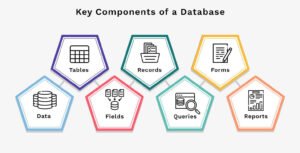What is a Database?
A database is a structured collection of data that is organized and stored in such a way that it can be easily accessed, managed, and updated. It acts as a digital repository where information is not only stored but also processed efficiently to support various operations like querying, reporting, and analysis.

In everyday life, databases are all around us. From storing user profiles on social media platforms to managing inventory in online stores or keeping patient records in hospitals — databases are the backbone of data-driven systems.
A Database Management System (DBMS) is software that enables users and applications to interact with the database. It provides tools for adding, retrieving, updating, and deleting data while ensuring data security, consistency, and integrity.
Key Characteristics of a Database:
- Structured Format: Data is stored in rows and columns (in relational databases), making it easy to organize and retrieve.
- Efficient Access: Optimized for speed and performance, allowing complex queries to return results quickly.
- Multi-user Environment: Supports simultaneous access by multiple users without conflict.
- Data Integrity & Security: Enforces rules to ensure accurate and authorized data handling.
- Persistent Storage: Data remains available even after system shutdown or failure.
Example Scenario:
Imagine a library system. Instead of maintaining piles of paper logs, a digital database can store all information—books, members, issued books, return dates, etc.—in an organized format. This makes tracking, searching, and updating records fast and reliable.